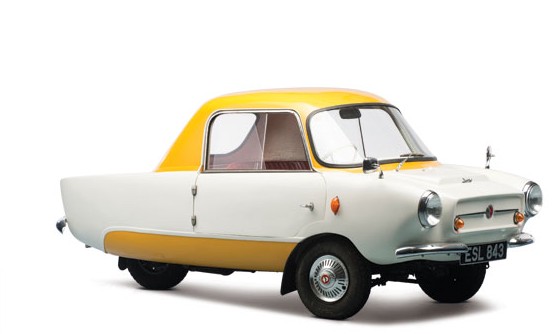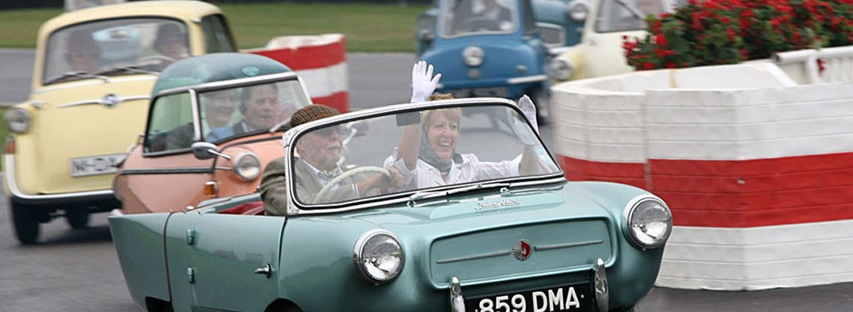It’s one of those ironies in life: in the 2 decades after WW2 Europe was in a mess. People had very little money but there was an urgent need to revive the European economies. many of the cars that were produced at this time were put together on a shoestring and were basic at best. A brand new BMW Isetta cost less than £240 on the road in 1960. In 2019, a concours condition BMW Isetta would cost you more like £24000. How times change.
One of the major problems was workforce mobility: people couldn’t afford cars. However, otherwise unemployed aircraft manufacturers such as Dornier, Heinkel & Messerschmitt began to produce small (micro) cars in Germany. Italy’s ISO produced and licensed the Isetta for manufacture across the World, BMW acquired a licence to produce these bubble cars in places such as Brighton, England (see below)

BMW also produced the BMW 600 & 700 models, both economy cars. The BMW 600 looks like an enlarged version of the Isetta, and is often accordingly misnamed as an Isetta. The 700, produced from 1959-65, looks more like a conventional car, albeit a small one. It’s a fact that the BMW 700 saved its iconic manufacturer from bankruptcy. Yes, that’s right; the funny-looking car below is the saviour of BMW and of all it subsequently has produced.

There’s more about the BMW 700 story here.
Over in the UK the story was much the same. The UK was economically ruined by WW2 & the UK didn’t benefit from reconstruction funds in the way that Europe did. As a consequence this period of car manufacturing in the UK (primarily in England) spawned a legion of quirky, whacky & downright bonkers microcars some of which can be seen in the header picture above.
The car at the head of this Goodwood Revival meeting (back in 2006) is the Meadows Frisky Sport Convertible. Meadows Frisky produced a number of other microcars, including the slightly dodgy-sounding “Frisky Family Three” (see below) which, despite its Michelotti styling, didn’t really sell.

Behind the Frisky Sport in this Goodwood Revival lineup is the hugely collectable Messerschmitt KR175/200. Manufactured, obviously, by the German aircraft manufacturer responsible for the ME109 fighter (amongst others). Indeed, the cockpit cover of the Messerschmitt KR series is from the ME109 fighter, as you can see from the picture below.
These days Messerschmitt KR Series cars are like gold dust. They’re worth a fortune: strange outcome for a car made from leftover war materials that emphasised the need for cheap, economical and functional transport.

Back to that Goodwood Revival header photo and we can see what look like a couple of BMW 600s followed by a Peel P50, which still holds the Guinness World Record of “World’s smallest production car”.
The Peel P50 was manufactured during the early 1960s on the Isle of Man in the Irish Sea to the west of northern England, south of Scotland and east of the island of Ireland. Peel Engineering built 50 of them, over half of which still survive, “to seat 1 adult and a shopping bag”. The P50 is so light it can be moved by hand, which is just as well as it doesn’t reverse. It has a 49cc DKW 2-stroke engine, a headlight and a windscreen wiper.
One of the 27 or so remaining P50s, which cost £199 new, was sold at auction in 2016 for US $176,000. These cars were revived in 2010 on the BBC “Dragon’s Den” programme and production restarted in Nottinghamshire, England of both the Peel P50 and the Peel Trident, its bubble-canopied stable mate, pictured below and bringing up the distant reat in the Goodwood Revival photograph. These are available as petrol and electric vehicles.
Behind the Peel P50 at Goodwood is a Bond 3-wheeler Minicar. It’s hard to say for sure but it looks like a Minicar Mark E, F or G. This would have been powered by a 197cc Villiers 2-stroke engine in the Minicar Mark E and a 250cc Villiers in the F and G Marks.
These 1950s and 1960s English microcars are not so well-known and collectible as some of their European counterparts, but we think they will be and they’re growing in value. Bond was also responsible for the much better-known 1970s icon known as the Bond Bug (see below).


There’s a saying that “necessity is the mother of invention”; this is certainly the case in the history of the microcar. Many of these vehicles were scratched together from what little was available by way or raw materials in order to get people moving so that post war economies could start to gain momentum and recover, which they did.
The microcars are products of their time and circumstance. We’re pretty sure that it would never have occurred to people in the 1950s and 1960s that this cheap, functional transport would be worth a lot of money 50 years later.



